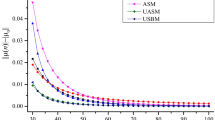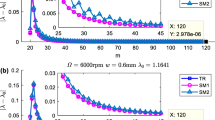Abstract
Chatter is a kind of self-excited vibrations which is related to regenerative effect, mode coupling effect, and process damping, etc. To predict milling chatter more accurately, a suitable dynamical model of milling process which can reflect the practical chatter mechanism should be obtained firstly. In this paper, a new milling dynamical model which simultaneously considers the regenerative effect, mode coupling effect, and process damping is established. Based on the new dynamical model and the updated full-discretization method (FDM), the coupling influences of regenerative effect, mode coupling effect, and process damping on the accurate of the stability lobe diagrams (SLDs) for up-milling and down-milling operations are investigated. A series of numerical simulation and experiments are carried out to verify the accuracy of the proposed milling dynamical model. The experiment results show that the mode coupling effect and process damping have great influences on the prediction of milling stability. The SLD which obtained by the new milling dynamical equation (considering the regenerative effect, mode coupling, and process damping) is more accurate than that which obtained by only considering the regenerative effect.
Similar content being viewed by others
References
Faassen RPH, van de Wouw N, Oosterling JAJ, Nijmeijer H (2003) Prediction of regenerative chatter by modelling and analysis of high-speed milling. Int J Mach Tools Manuf 43(14):1437–1446. https://doi.org/10.1016/S0890-6955(03)00171-8
Tlusty J, Polacek M (1963) The stability of machine tools against self excited vibrations in machining. ASME Production Engineering Research Conference, Pittsburgh, PA, pp 465–474
Tunc T, Budak E (2013) Identification and modeling of process damping in milling. J Manuf Sci Eng 135(2):1–12. https://doi.org/10.1115/1.4023708
Liu XB, Vlajic N, Long XH, Meng G, Balachandran B (2014) Multiple regenerative effects in cutting process and nonlinear oscillations. Int J Dynam Control 2(1):86–101. https://doi.org/10.1007/s40435-014-0078-5
Balachandran B (2001) Nonlinear dynamics of milling processes. Philos Trans R Soc Lond A 359(1781):793–819. https://doi.org/10.1098/rsta.2000.0755
Richard T, Germay C, Detournay E (2004) Self-excited stick-slip oscillations of drill bits. C R Mec 332(8):619–626. https://doi.org/10.1016/j.crme.2004.01.016
Quintana G, Ciurana J (2011) Chatter in machining processes: a review. Int J Mach Tools Manuf 51(5):363–376. https://doi.org/10.1016/j.ijmachtools.2011.01.001
Altintas Y, Budak E (1995) Analytical prediction of stability lobes in milling. CIRP Ann-Manuf Technol 44(1):357–362. https://doi.org/10.1016/S0007-8506(07)62342-7
Merdol SD, Altintas Y (2004) Multi frequency solution of chatter stability for low immersion milling. J Manuf Sci Eng-Trans ASME 126(3):459–466. https://doi.org/10.1115/1.1765139
Minis I, Yanushevsky R (1993) A new theoretical approach for the prediction of machine tool chatter in milling. J Eng Ind 115(1):1–8. https://doi.org/10.1115/1.2901633
Insperger T, Stépán G (2004) Updated semi-discretization method for periodic delay-differential equations with discrete delay. Int J Numer Methods Eng 61(1):117–141. https://doi.org/10.1002/nme.1061
Ding Y, Zhu LM, Zhang XJ, Ding H (2010) A full-discretization method for prediction of milling stability. Int J Mach Tools Manuf 50(5):502–509. https://doi.org/10.1016/j.ijmachtools.2010.01.003
Yan ZH, Wang XB, Liu ZB, Wang DQ, Jiao L, Ji YJ (2017) Third-order updated full-discretization method for milling stability prediction. Int J Adv Manuf Technol 92(5–8):2299–2309. https://doi.org/10.1007/s00170-017-0243-z
Yan ZH, Wang XB, Liu ZB, Wang DQ, Ji YJ, Jiao L (2017) Orthogonal polynomial approximation method for stability prediction in milling. Int J Adv Manuf Technol 91(9–12):4313–4330. https://doi.org/10.1007/s00170-017-0067-x
Zhou K, Feng PF, Xu C, Zhang JF, Wu ZJ (2017) High-order full-discretization methods for milling stability prediction by interpolating the delay term of time-delayed differential equations. Int J Adv Manuf Technol 93(5–8):2201–2214. https://doi.org/10.1007/s00170-017-0692-4
Ding Y, Zhu LM, Zhang XJ, Ding H (2011) Numerical integration method for prediction of milling stability. J Manuf Sci Eng 133(3):1–9. https://doi.org/10.1115/1.4004136
Ding Y, Zhu LM, Zhang XJ, Ding H (2011) Milling stability analysis using the spectral method. Sci China Technol Sci 54(12):3130–3136. https://doi.org/10.1007/s11431-011-4611-x
Zhang Z, Li HG, Meng G, Liu C (2015) A novel approach for the prediction of the milling stability based on the Simpson method. Int J Mach Tools Manuf 99:43–47. https://doi.org/10.1016/j.ijmachtools.2015.09.002
Balachandran B, Gilsinn D (2005) Non-linear oscillations of milling. Math Comput Model Dyn Syst 11(3):273–290. https://doi.org/10.1080/13873950500076479
Zhao MX, Balachandran B (2001) Dynamics and stability of milling process. Int J Solids Struct 38(10–13):2233–2248. https://doi.org/10.1016/S0020-7683(00)00164-5
Balachandran B, Zhao MX (2000) A mechanics based model for study of dynamics of milling operations. Meccanica 35(2):89–109. https://doi.org/10.1023/A:1004887301926
Zhang XJ, Xiong CH, Ding Y, Feng MJ, Xiong YL (2012) Milling stability analysis with simultaneously considering the structural mode coupling effect and regenerative effect. Int J Mach Tools Manuf 53(1):127–140. https://doi.org/10.1016/j.ijmachtools.2011.10.004
Gasparetto A (1998) A system theory approach to mode coupling chatter in machining. J Dyn Sys, Meas, Control 120(4):545–547. https://doi.org/10.1115/1.2801501
Gasparetto A (2001) Eigenvalue analysis of mode-coupling chatter for machine-tool stabilization. J Vib Control 7(2):181–197. https://doi.org/10.1177/107754630100700203
Gallina P, Trevisani A (2003) On the stabilizing and destabilizing effects of damping in wood cutting machines. Int J Mach Tools Manuf 43(9):955–964. https://doi.org/10.1016/S0890-6955(03)00061-0
Hoffmann N, Gaul L (2003) Effects of damping on mode-coupling in stability in friction induced oscillations. ZAMM-J Appl Math Mech 83(8):524–534. https://doi.org/10.1002/zamm.200310022
Pan ZX, Zhang H, Zhu ZQ, Wang JJ (2006) Chatter analysis of robotic machining process. J Mater Process Technol 173(3):301–309. https://doi.org/10.1016/j.jmatprotec.2005.11.033
Iturrospe A, Atxa V, Abete JM (2007) State-space analysis of mode-coupling in orthogonal metal cutting under wave regeneration. Int J Mach Tools Manuf 47(10):1583–1592. https://doi.org/10.1016/j.ijmachtools.2006.11.005
Li ZY, Jiang SL, Sun YW (2017) Chatter stability and surface location error predictions in milling with mode coupling and process damping. Proc IMechE Part B: J Eng Manuf:1–13. https://doi.org/10.1177/0954405417708225
Wallace PW, Andrew C (1965) Machining forces: some effects of tool vibration. J Mech Eng Sci 7(2):152–162. https://doi.org/10.1243/JMES_JOUR_1965_007_023_02
Ahmadi K, Altintas Y (2014) Identification of machining process damping using output-only modal analysis. J Manuf Sci Eng-Trans ASME 136(5):051017. https://doi.org/10.1115/1.4027676
Ahmadi K, Ismail F (2012) Stability lobes in milling including process damping and utilizing multi-frequency and semi-discretization methods. Int J Mach Tools Manuf 54-55:46–54. https://doi.org/10.1016/j.ijmachtools.2011.11.007
Huang CY, Wang JJJ (2007) Mechanistic modeling of process damping in peripheral milling. J Manuf Sci Eng 129(1):12–20. https://doi.org/10.1115/1.2335857
Ahmadi K, Ismail F (2011) Analytical stability lobes including nonlinear process damping effect on machining chatter. Int J Mach Tools Manuf 51(4):296–308. https://doi.org/10.1016/j.ijmachtools.2010.12.008
Ahmadi K (2017) Analytical investigation of machining chatter by considering the nonlinearity of process damping. J Sound Vibr 393:252–264. https://doi.org/10.1016/j.jsv.2017.01.006
Malekian M, Park SS, Jun MBG (2009) Modeling of dynamic micro-milling cutting forces. Int J Mach Tools Manuf 49(7–8):586–598. https://doi.org/10.1016/j.ijmachtools.2009.02.006
Lu YA, Ding Y, Zhu LM (2017) Dynamics and stability prediction of five-Axis flat-end milling. J Manuf Sci Eng 139(6):1–11. https://doi.org/10.1115/1.4035422
Wu DW (1989) A new approach of formulating the transfer function for dynamic cutting process. J Eng Ind 111(1):37–47. https://doi.org/10.1115/1.3188730
Kurata Y, Merdol SD, Altintas Y, Suzuki N, Shamoto E (2010) Chatter stability in turning and milling within process identified process damping. J Adv Mech Design, Syst, Manuf 4(6):1107–1118. https://doi.org/10.1299/jamdsm.4.1107
Chiou YS, Chung ES, Liang SY (1995) Analysis of tool wear effect on chatter stability in turning. Int J Mech Sci 37(4):391–404. https://doi.org/10.1016/0020-7403(94)00070-Z
Ji YJ, Wang XB, Liu ZB, Wang HJ, Yan ZH (2018) An updated full-discretization milling stability prediction method based on the higher order Hermite-Newton interpolation polynomial. Int J Adv Manuf Technol 95(5–8):2227–2242. https://doi.org/10.1007/s00170-017-1409-4
Insperger T, Stépán G, Turi J (2008) On the higher-order semi-discretizations for periodic delayed systems. J Sound Vib 313(1–2):334–341. https://doi.org/10.1016/j.jsv.2007.11.040
Guo Q, Sun YW, Jiang Y (2012) On the accurate calculation of milling stability limits using third-order full-discretization method. Int J Mach Tools Manuf 62:61–66. https://doi.org/10.1016/j.ijmachtools.2012.05.001
Liu YL, Zhang DH, Wu BH (2012) An efficient full-discretization method for prediction of milling stability. Int J Mach Tools Manuf 63:44–48. https://doi.org/10.1016/j.ijmachtools.2012.07.008
Farkas M (ed) (1994) Periodic motions. Springer-Verlag, New York
Ahmadi K, Ismail F (2012) Investigation of finite amplitude stability due to process damping in milling. Procedia CIRP 1:60–65. https://doi.org/10.1016/j.procir.2012.04.009
Elbestawi MA, Ismail F, Du R, Ullagaddi BC (1994) Modeling machining dynamics including damping in the tool-workpiece interface. J Eng Ind 116(4):435–439. https://doi.org/10.1115/1.2902125
Gradisek J, Kalveram M, Insperger T, Weinert K, Stepan G, Govekar E, Grabec I (2005) On stability prediction for milling. Int J Mach Tools Manuf 45(7–8):769–781. https://doi.org/10.1016/j.ijmachtools.2004.11.015
Ding Y (2011) milling dynamics-stability analysis methods and applications, Doctoral Dissertation, Shanghai Jiao Tong University
Long XH, Balachandran B (2010) Stability of up-milling and down-milling operations with variable spindle speed. J Vib Control 16(7–8):1151–1168. https://doi.org/10.1177/1077546309341131
Wang MH, Lei G, Zheng YH (2014) An examination of the fundamental mechanics of cutting force coefficients. Int J Mach Tools Manuf 78:1–7 https://doi.org/10.1016/j.ijmachtools.2013.10.008
Acknowledgements
This work is jointly supported by the National Natural Science Foundation of China (Grant No. 51375055 and 51575055); The High-end CNC machine tools and basic manufacturing equipment Science and Technology Major Project of China (Grant No. 2015ZX04001002); Junior Fellowships for CAST Advanced Innovation Program (DXB-ZKQN-2016-003).
Author information
Authors and Affiliations
Corresponding author
Rights and permissions
About this article
Cite this article
Ji, Y., Wang, X., Liu, Z. et al. Milling stability prediction with simultaneously considering the multiple factors coupling effects—regenerative effect, mode coupling, and process damping. Int J Adv Manuf Technol 97, 2509–2527 (2018). https://doi.org/10.1007/s00170-018-2017-7
Received:
Accepted:
Published:
Issue Date:
DOI: https://doi.org/10.1007/s00170-018-2017-7




